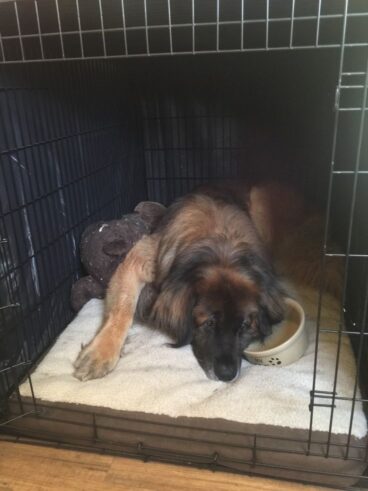Crate training can be a valuable tool for raising a happy, well-adjusted Leonberger puppy. While the idea of crate training a giant breed might seem daunting at first—especially when your fluffy pup is going to grow into a 60–80 kg adult—it’s one of the most effective ways to create structure, promote safety, and support your Leonberger’s development. Whether you’re new to dog ownership or experienced with giant breeds, this guide offers practical, breed-specific advice on crate training your Leonberger pup.
Why Crate Train a Leonberger?
Leonbergers are gentle, affectionate dogs that thrive on routine and companionship. Crate training offers many benefits, including:
- Safety: A crate provides a secure environment when you’re not able to supervise your pup.
- House Training: Crates encourage bladder and bowel control because dogs instinctively avoid soiling their sleeping area.
- Travel and Vet Visits: A crate-trained Leonberger is much more comfortable during car rides and stays at the vet.
- Creating a Safe Haven: The crate becomes a calming, personal space—especially helpful for puppies adjusting to a new home.
Choosing the Right Crate Size
Leonbergers grow fast and will need a large crate (at least 120 cm long) to accommodate their size as adults. However, for crate training a young puppy:
- Use a crate with a divider so the space can grow with your pup.
- Too much space can lead to toileting accidents. Adjust the size so they can comfortably stand up, turn around, and lie down.
💡 Tip: Wire crates with removable dividers are ideal—they’re breathable, secure, and allow visibility, which helps with separation anxiety.
Step-by-Step Crate Training Process
1. Introduce the Crate Positively
- Place the crate in a quiet, low-traffic area—but close enough that your puppy doesn’t feel isolated.
- Leave the door open and encourage your puppy to explore the crate by tossing treats or placing their favourite toy or blanket inside.
- Praise them for sniffing or entering voluntarily. Avoid forcing them inside.
2. Create Positive Associations
- Feed your Leonberger pup their meals in the crate to build a strong, positive connection.
- Start closing the door during mealtime and open it when they’re finished, gradually increasing the time the door remains closed.
3. Begin Short Sessions
- Once your pup is comfortable eating in the crate, try short crate sessions while you’re nearby.
- Use a cue word like “crate” or “bed” each time they enter.
- Begin with 5–10 minutes and slowly increase as your puppy gets used to the routine.
4. Practice Crating with You Out of Sight
- Step out of the room briefly and return before your puppy becomes distressed.
- Gradually build up to longer absences.
- Avoid making a fuss when leaving or returning, as this can create anxiety.
5. Night-Time Crating
- Place the crate near your bed during the early stages so your pup doesn’t feel alone.
- Most Leonberger puppies will need a toilet break during the night. Set an alarm or listen for whining or restlessness.
- Take them out calmly, on lead, and return them to the crate with minimal fuss.
Common Challenges (And Solutions)
Whining or Barking:
- If your puppy cries, wait a moment to see if they settle. Don’t immediately open the crate unless you suspect they need to toilet.
- Ensure your pup has had exercise, food, and a toilet break before crating.
Resistance to Entering the Crate:
- Never use the crate as punishment. This can create negative associations.
- Increase crate rewards: use special treats or food puzzles your pup only gets in the crate.
Outgrowing the Crate Too Fast:
- Adjust the divider weekly as your pup grows.
- Upgrade to an adult-sized crate by 6–8 months if needed.
Crate Training Tips Specifically for Leonbergers
- Gentle Giants Need Gentle Handling: Leonbergers are sensitive and thrive on positive reinforcement. Harsh discipline or scolding will damage trust and slow progress.
- Avoid Over-Crating: These social dogs don’t tolerate being crated for long periods. A general rule is 1 hour for each month of age (e.g., 3-month-old pup = 3 hours max), up to about 5 hours.
- Watch for Overheating: Leonbergers have thick coats and can overheat easily. Ensure the crate is well-ventilated and not in direct sunlight.
- Include Soft Bedding: Choose durable, chew-resistant bedding that supports joints—especially important for growing giant breeds.
- Stick to a Routine: Leonbergers thrive on predictability. Feed, crate, walk, and play at consistent times each day.
When Crate Training Isn’t Working
If your Leonberger pup shows signs of serious anxiety—excessive drooling, scratching to escape, or fear of entering the crate—stop and reassess. It may help to:
- Take a short break from training.
- Go back to shorter sessions with the door open.
- Use calming aids like pheromone diffusers or calming music.
- Consult a dog trainer experienced with giant breeds.
Final Thoughts
Crate training a Leonberger is an investment in your puppy’s wellbeing and your home’s harmony. When introduced with care, patience, and positivity, the crate becomes more than a training tool—it becomes a comforting den where your Leonberger feels safe and loved.
Remember, every puppy is unique. Some Leonbergers may take to the crate quickly, while others may need more time. Stay consistent, kind, and tuned in to your pup’s cues, and you’ll build a trusting bond that lasts a lifetime.
Looking for more tips on raising your Leonberger?
Browse our blog for articles on feeding, grooming, and socialising your gentle giant, or get in touch with us—we’re always happy to help new puppy parents start their journey with confidence.




